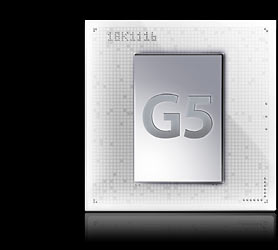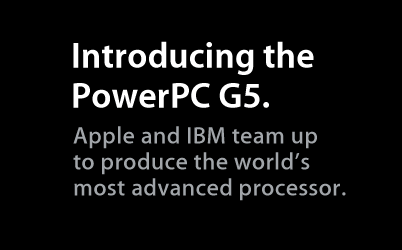Forged
from a long-standing partnership between two companies committed to
innovation, the G5 drives the largest performance gain in the history
of the PowerPC. The 64-bit G5 speeds up to 2GHz and can address 8GB
main memory.
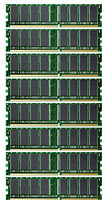 Shatters the 4GB ceiling
Shatters the 4GB ceiling
32-bit PCs can only use 4GB of memory. Any more than that requires the use of virtual memory on the hard drive, which is 40 times slower than using RAM. The new Power Mac G5 can offer up to 8GB of RAM thanks to the 64-bit G5. So you can store entire 3D worlds, huge scientific data sets and oversized 2D images all in main memory, which lets you manipulate them faster. To repeat: 40 times faster. Theoretically, the 64-bit data paths let the Power PC G5 access up to 4 terabytes of physical memory. Impractical now, maybe, but the Power PC G5 architecture allows for plenty of growth well into the future.
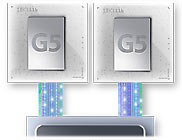 Magic bus
Magic bus
And to get at that data, the PowerPC G5 features an industry-leading 1GHz frontside bus for each processor, offering a staggering 16 GBps throughput on dual PowerPC G5 systems. That’s a huge leap over today’s Power Mac G4, with a bus speed of
167MHz. That means you won’t have a bottleneck getting information to
the chip for processing.
Award-winning logic
The PowerPC G5 gets its smarts from the execution core of IBM’s 64-bit POWER4 processor — recipient of the
Microprocessor Report’s 2001 Analyst’s Choice Award for Best
Workstation/Server Processor. The POWER4 drives IBM’s successful eBusiness servers, with highly parallel processing, two double-precision floating-point units and advanced branch prediction logic. Apple collaborated with IBM to leverage this industry-leading design for the G5, combining an optimized Velocity Engine with a new superscalar, superpipelined execution core that supports more than 200 simultaneous in-flight instructions. But you won’t have to buy new
software to take advantage of the Power Mac G5 speed boost, because
Apple and IBM designed the PowerPC architecture to scale from 32- to
64-bit from the beginning.
|
Putting the
power in PowerPC
We ran the 64-bit PowerPC G5 through a series of SPEC tests — the industry standard for
performance testing — head-to-head against a 32-bit Pentium 4 and a 32-bit Xeon (essentially the dual-processor version of the Pentium 4). The SPECint and SPECfp tests measured integer and floating point peformance, and the results (see chart) should make your pulse race just a little bit faster.
| System
Throughput |
| |
SPECfp_rate_base2000 |
SPECint_rate_base2000 |
Dual 2GHz
PowerPC G5 |
15.7 |
17.2 |
Dual
3.06GHz Xeon |
11.1 |
16.7 |
Single 3GHz
Pentium 4 |
8.07 |
10.3 |
SPECint_base2000 and
SPECfp_base2000 measure the speed of a single task — either an integer
calculation or a floating-point calculation — executing on a single
processor. Each test measures how long the processor takes to complete
the benchmark set of single tasks.
|
| Single
Processor Speed |
| |
SPECfp_base2000 |
SPECint_base2000 |
Single 2GHz
PowerPC G5 |
840 |
800 |
Single
3.06GHz Xeon |
646 |
836 |
Single 3GHz
Pentium 4 |
693 |
889 |
The “SPEC rate” metrics -
SPECint_rate_base2000 and SPECfp_rate_base2000, recognize multiple
processors and more accurately demonstrate the performance of a dual
processor system — which are, of course, the fastest systems. The
results should make your pulse race just a little bit faster.
|
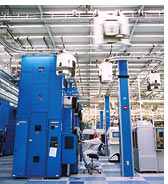 Manufacturing marvel Manufacturing marvel
What’s more, all this power is fabricated in IBM’s state-of-the-art 130-nanometer process technology using high-performance Silicon-on-Insulator transistors and copper interconnects. Switches store the instructions that the PowerPC G5 ultimately processes in its execution core. Making these transistors smaller and more numerous boosts performance, but presents challenges. Imagine fitting over 58 million light switches into the space the size of your thumbnail to comprehend the feat accomplished by IBM scientists and fabrication wizards. |
